Drag Me
Loading Radar...
One Moment Please.
Drag Me
Loading...
Drag Me
Loading...
Drag Me
Loading...
Drag Me
Loading...
Click here to drag, again to release.
3DWebWorldz Quick Tutorial 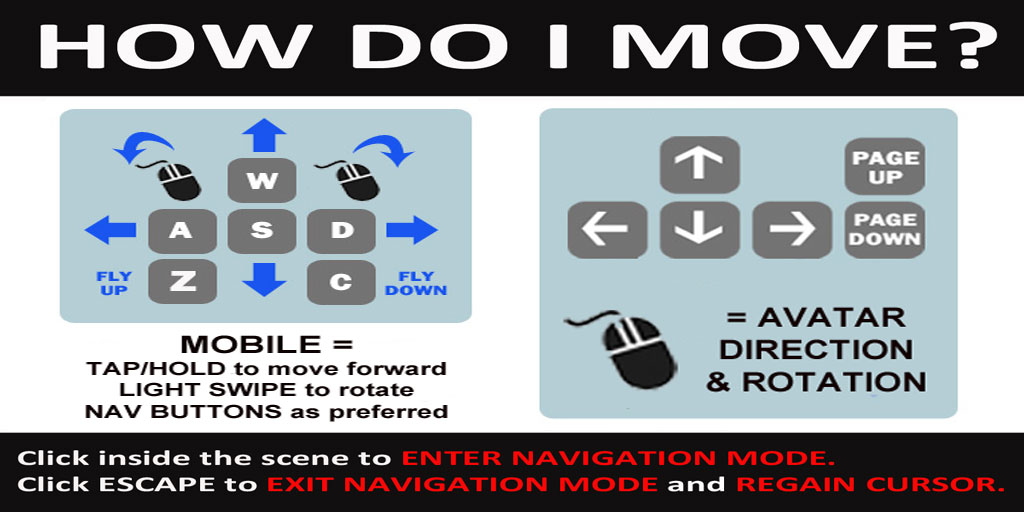
Click a Button Below to Learn More or:

Click a Button Below to Learn More or:
This museum contains exhibits from the Virginia Museum of Natural History
 Thank you for visiting.
Thank you for visiting.Please remember to LOG OUT when you are done for the day!
Customize Your Interface
Descriptions provided during option hover.ACTIVE CAMERA:
3rd Person, Default.
CURSOR: Click inworld for navigation/interaction mode. ESCAPE KEY to exit.HELLO: YOU ARE HERE: ADVENTURES | Museum of Natural History, Virginia | #149.
DRAG HUD HERE
Click here to drag, again to release.
Channel:149AVATAR ANIMATIONS
**turn on FREE CAM to lock in animation**
**turn on FREE CAM to lock in animation**
Nudge avatar position.
POINTER HUD - DRAG HERE
DRAG HUD HERE
Click here to drag, again to release.
Click here to drag, again to release.
Change Your Emoji Head. White descriptions = Public Library; Blue Descriptions = Your Private Inventory.
INSTACHAT BUBBLE
*
*
If scrolling is not available on your device, press ESC to regain cursor.
ELEVATOR is for AVATARS ONLY
Change your 3DWebWorldz Focus Point to close window or use button below.
You may need to enable browser pop-ups to access links included in this window.
ART GALLERY ELEVATOR
ELEVATOR is for AVATARS ONLY
Portal Websites use the teleport button on bottom toolbar.
Change your 3DWebWorldz Focus Point to close window or use button below.
You may need to enable browser pop-ups to access links included in this window.
If scrolling is not available on your device, press ESC to regain cursor.
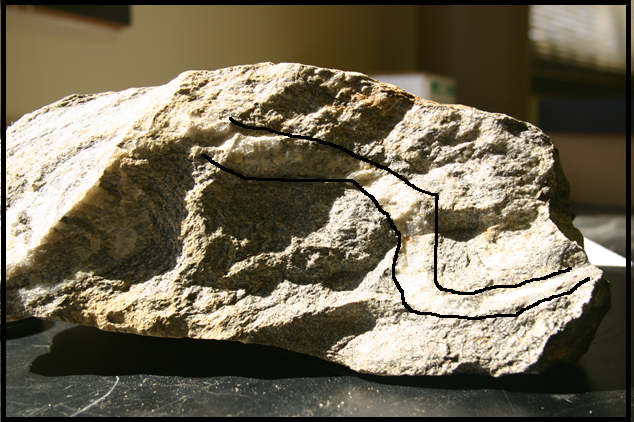
Change your 3DWebWorldz Focus Point to close window or use button below.
You may need to enable browser pop-ups to access links included in this window.
Blue Ridge

These Mountains contain metamorphic rocks like this Gneiss. These formed under very high pressures and temperatures as North America and Europe collided 320 million years ago.
Change your 3DWebWorldz Focus Point to close window or use button below.
You may need to enable browser pop-ups to access links included in this window.
If scrolling is not available on your device, press ESC to regain cursor.
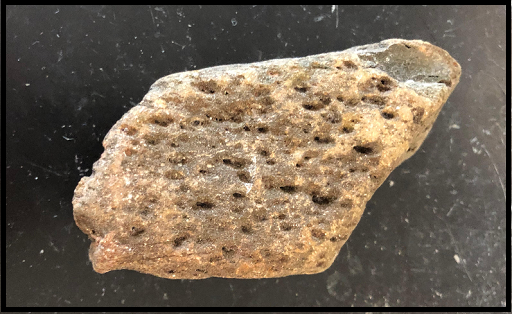
Change your 3DWebWorldz Focus Point to close window or use button below.
You may need to enable browser pop-ups to access links included in this window.
Bald Knob 1

This picture was taken from the top of Bald Knob in Rocky Mount, Va. You can see Grassy Hill in the distance. These are ancient underwater volcano deposits as shown by the pore rich basalt. These volcanoes formed as North and South America split apart and represent the breaking apart of Rodinia, a supercontinent.
Change your 3DWebWorldz Focus Point to close window or use button below.
You may need to enable browser pop-ups to access links included in this window.
If scrolling is not available on your device, press ESC to regain cursor.
Change your 3DWebWorldz Focus Point to close window or use button below.
You may need to enable browser pop-ups to access links included in this window.
Granite 3
450 million years ago, a volcanic island arc existed off North America similar to Japan off Asia Today. This igneous granite found in Martinsville is evidence of this.
Change your 3DWebWorldz Focus Point to close window or use button below.
You may need to enable browser pop-ups to access links included in this window.
If scrolling is not available on your device, press ESC to regain cursor.
Change your 3DWebWorldz Focus Point to close window or use button below.
You may need to enable browser pop-ups to access links included in this window.
Price 4
These sedimentary rocks found near Roanoke are 280 million years old. The folding occurred as North America and Africa collided to form the supercontinent Pangea, which occurred 230 million years ago after the rocks were deposited.
Change your 3DWebWorldz Focus Point to close window or use button below.
You may need to enable browser pop-ups to access links included in this window.
If scrolling is not available on your device, press ESC to regain cursor.
Change your 3DWebWorldz Focus Point to close window or use button below.
You may need to enable browser pop-ups to access links included in this window.
Olivine 5
This basalt contains the green mineral Olivine, which indicates this rock when it was molten came from the mantle. Olivine only forms in the mantle of the Earth.
Change your 3DWebWorldz Focus Point to close window or use button below.
You may need to enable browser pop-ups to access links included in this window.
If scrolling is not available on your device, press ESC to regain cursor.
Change your 3DWebWorldz Focus Point to close window or use button below.
You may need to enable browser pop-ups to access links included in this window.
Ord title6
Glacial deposits called Tills in Africa indicate that 450 million years ago, sea level was lower and the continental shelves were drained, but other factors contributed to the Late Ordovician extinction.
Change your 3DWebWorldz Focus Point to close window or use button below.
You may need to enable browser pop-ups to access links included in this window.
If scrolling is not available on your device, press ESC to regain cursor.
Change your 3DWebWorldz Focus Point to close window or use button below.
You may need to enable browser pop-ups to access links included in this window.
Graptolite 7
Graptolites look like jellyfish but are actually related to early chordates, Some of these went extinct 450 million years ago. As fossils they look like pencil marks on the rock.
Change your 3DWebWorldz Focus Point to close window or use button below.
You may need to enable browser pop-ups to access links included in this window.
If scrolling is not available on your device, press ESC to regain cursor.
Change your 3DWebWorldz Focus Point to close window or use button below.
You may need to enable browser pop-ups to access links included in this window.
Ceph8
Cephalopods were early squid like animals that were carnivores. There were other predators in the seas 450 million years ago, making life difficult back then.
Change your 3DWebWorldz Focus Point to close window or use button below.
You may need to enable browser pop-ups to access links included in this window.
If scrolling is not available on your device, press ESC to regain cursor.
Change your 3DWebWorldz Focus Point to close window or use button below.
You may need to enable browser pop-ups to access links included in this window.
Volcanic Ash 9
These volcanic ash beds can be found in rocks of Ordovician age and indicate that violent volcanoes erupted 450 million years ago perhaps killing off marine life.
Change your 3DWebWorldz Focus Point to close window or use button below.
You may need to enable browser pop-ups to access links included in this window.
If scrolling is not available on your device, press ESC to regain cursor.
Change your 3DWebWorldz Focus Point to close window or use button below.
You may need to enable browser pop-ups to access links included in this window.
clams 10
These clams were invasive species 450 million years ago, they may have stirred up the sediment making it difficult for brachiopods to live on the sea floor. The brachiopods would have sunk into the sediment clogging their organs needed to get oxygen and food.
Change your 3DWebWorldz Focus Point to close window or use button below.
You may need to enable browser pop-ups to access links included in this window.
If scrolling is not available on your device, press ESC to regain cursor.
Change your 3DWebWorldz Focus Point to close window or use button below.
You may need to enable browser pop-ups to access links included in this window.
ord Summary 11
To summarize, some graptolites went extinct, then cephalopods, and finally some brachiopods went extinct or buried into the sediment to avoid extinction at the end of the Ordovician 450 million years ago.
Change your 3DWebWorldz Focus Point to close window or use button below.
You may need to enable browser pop-ups to access links included in this window.
If scrolling is not available on your device, press ESC to regain cursor.
Change your 3DWebWorldz Focus Point to close window or use button below.
You may need to enable browser pop-ups to access links included in this window.
Cret sign 12
86 million years ago the central part of the US was covered with water. Part of this was due to melting of all polar ice and the rise of sea level, but something else was happening...
Change your 3DWebWorldz Focus Point to close window or use button below.
You may need to enable browser pop-ups to access links included in this window.
If scrolling is not available on your device, press ESC to regain cursor.
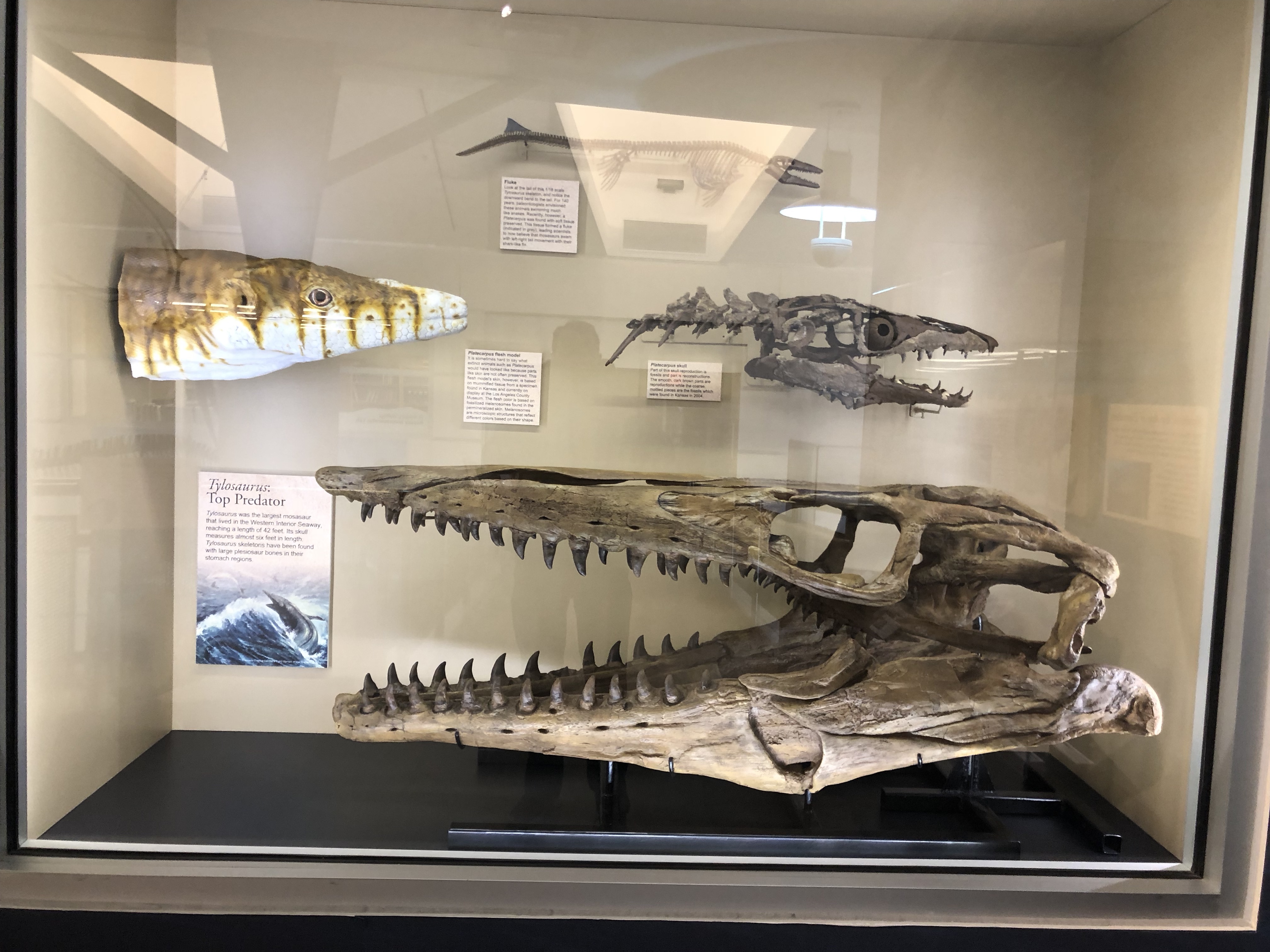
Change your 3DWebWorldz Focus Point to close window or use button below.
You may need to enable browser pop-ups to access links included in this window.
Tylosaur 13

During the Cretaceous, 87 Million years ago, Tylosaurs were the top predators in a seaway that covered the central part of North America. A model of a Tylosaur is above this display. As the Pacific plate went under the North America plate, the central part of the US was pulled down
Change your 3DWebWorldz Focus Point to close window or use button below.
You may need to enable browser pop-ups to access links included in this window.
If scrolling is not available on your device, press ESC to regain cursor.
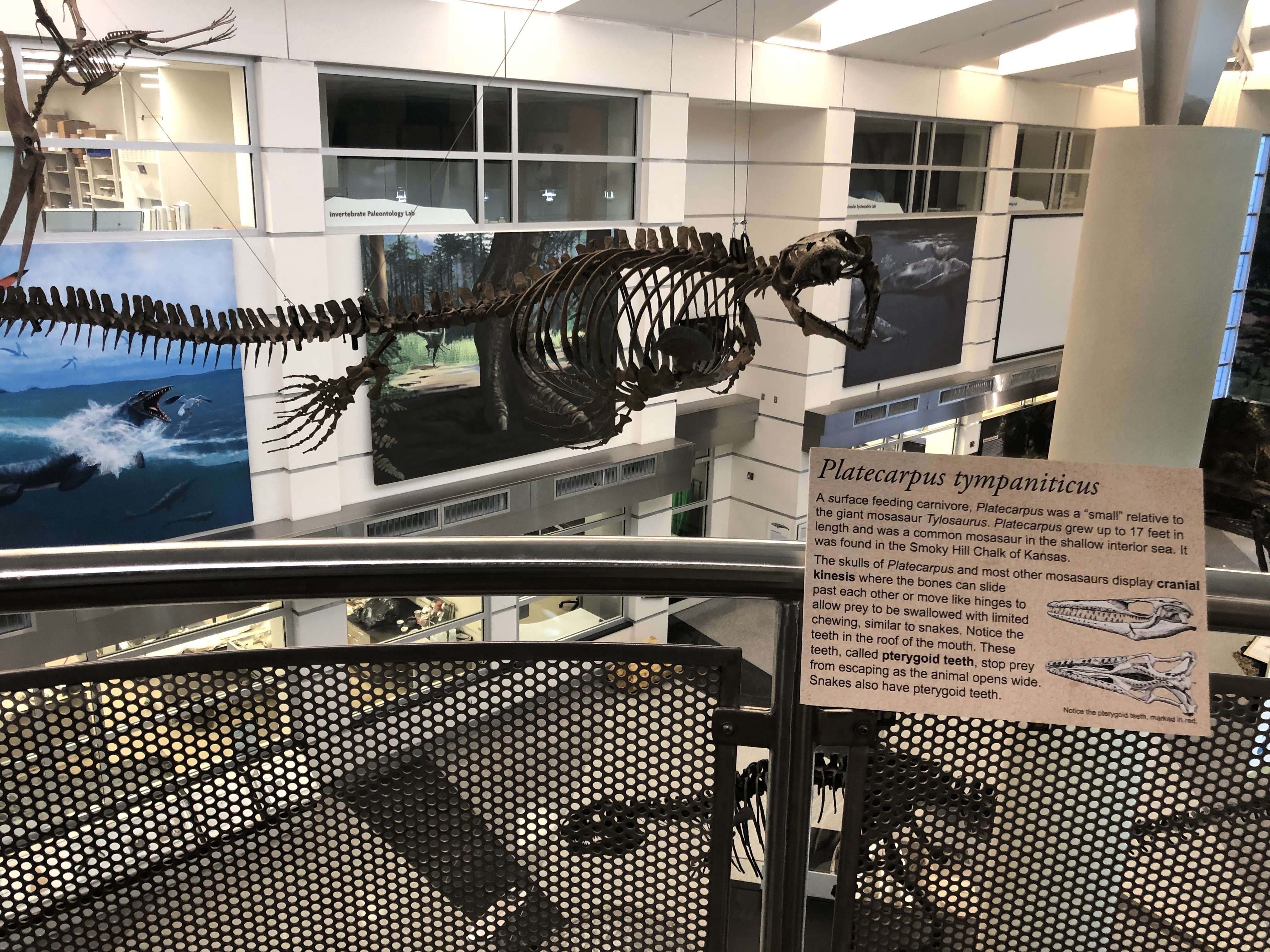
Change your 3DWebWorldz Focus Point to close window or use button below.
You may need to enable browser pop-ups to access links included in this window.
Platycarpus 14

Platycarpus was a swift predator in the seas of the Cretaceous. It's jaws were hinged to allow the animal to eat it's prey whole and had recurved teeth so the prey could not get away.
Change your 3DWebWorldz Focus Point to close window or use button below.
You may need to enable browser pop-ups to access links included in this window.
If scrolling is not available on your device, press ESC to regain cursor.
Change your 3DWebWorldz Focus Point to close window or use button below.
You may need to enable browser pop-ups to access links included in this window.
inos 15
These Cretaceous clams that lived 87 million years ago got to the size of basketballs. They died out 66 million years due to increased predation by arthropods such as crabs.
Change your 3DWebWorldz Focus Point to close window or use button below.
You may need to enable browser pop-ups to access links included in this window.
If scrolling is not available on your device, press ESC to regain cursor.
Change your 3DWebWorldz Focus Point to close window or use button below.
You may need to enable browser pop-ups to access links included in this window.
Dev 1
The Devonian time period was about 350 million years ago. Many animals died at the end of this time period perhaps due to the rise of plants on land, and nutrients flushed into the oceans which lead to lower oxygen levels as algae consumed the nutrients
Change your 3DWebWorldz Focus Point to close window or use button below.
You may need to enable browser pop-ups to access links included in this window.
If scrolling is not available on your device, press ESC to regain cursor.
Change your 3DWebWorldz Focus Point to close window or use button below.
You may need to enable browser pop-ups to access links included in this window.
Dev 2 17
An armored jawed fish from the Devonian 350 million years ago.
Change your 3DWebWorldz Focus Point to close window or use button below.
You may need to enable browser pop-ups to access links included in this window.
If scrolling is not available on your device, press ESC to regain cursor.
Change your 3DWebWorldz Focus Point to close window or use button below.
You may need to enable browser pop-ups to access links included in this window.
Olenellus 18
This trilobite is one of the oldest fossils in Virginia and lived here 540 million years ago. It is similar to crabs living today.
Change your 3DWebWorldz Focus Point to close window or use button below.
You may need to enable browser pop-ups to access links included in this window.
If scrolling is not available on your device, press ESC to regain cursor.
Change your 3DWebWorldz Focus Point to close window or use button below.
You may need to enable browser pop-ups to access links included in this window.
Saltella 19
The biologic relationship of this cone shaped fossil is unknown. It could have been related to today's squids, jellyfish or may be a new phylum of animlas. It is 540 million years old.
Change your 3DWebWorldz Focus Point to close window or use button below.
You may need to enable browser pop-ups to access links included in this window.
If scrolling is not available on your device, press ESC to regain cursor.
Change your 3DWebWorldz Focus Point to close window or use button below.
You may need to enable browser pop-ups to access links included in this window.
Archeo 20
These Archeocyathid fossils are 540 million years old, and are related to sponges today.
Change your 3DWebWorldz Focus Point to close window or use button below.
You may need to enable browser pop-ups to access links included in this window.
If scrolling is not available on your device, press ESC to regain cursor.
Change your 3DWebWorldz Focus Point to close window or use button below.
You may need to enable browser pop-ups to access links included in this window.
Spine brach 21
Spines on this brachiopods helped stabilize the animal in the sediment on the sea floor. They were too delicate to act as protection.
Change your 3DWebWorldz Focus Point to close window or use button below.
You may need to enable browser pop-ups to access links included in this window.
If scrolling is not available on your device, press ESC to regain cursor.
Change your 3DWebWorldz Focus Point to close window or use button below.
You may need to enable browser pop-ups to access links included in this window.
Coral 22
This fossil lived 345 million years ago during the Devonian, and is a coral.
Change your 3DWebWorldz Focus Point to close window or use button below.
You may need to enable browser pop-ups to access links included in this window.
If scrolling is not available on your device, press ESC to regain cursor.
Change your 3DWebWorldz Focus Point to close window or use button below.
You may need to enable browser pop-ups to access links included in this window.
Chesapectin 23
This is scallop fossil is the state fossil for Virginia. It was proposed that this be the state fossil by Thomas Jefferson.
Change your 3DWebWorldz Focus Point to close window or use button below.
You may need to enable browser pop-ups to access links included in this window.
If scrolling is not available on your device, press ESC to regain cursor.
Change your 3DWebWorldz Focus Point to close window or use button below.
You may need to enable browser pop-ups to access links included in this window.
Claws 0
This is Claws, an extinct ground sloth that lived in Virginia during the ice ages. Thomas Jefferson originally found bones of this animal in a cave and thought they were bear bones.
Change your 3DWebWorldz Focus Point to close window or use button below.
You may need to enable browser pop-ups to access links included in this window.
If scrolling is not available on your device, press ESC to regain cursor. Change your 3DWebWorld focus to close this window.

Change your 3DWebWorldz Focus Point to close window or use button below.
You may need to enable browser pop-ups to access links included in this window.
Tylosaur 13

During the Cretaceous, 87 Million years ago, Tylosaurs were the top predators in a seaway that covered the central part of North America. A model of a Tylosaur is above this display. As the Pacific plate went under the North America plate, the central part of the US was pulled down
Change your 3DWebWorldz Focus Point to close window or use button below.
You may need to enable browser pop-ups to access links included in this window.
If scrolling is not available on your device, press ESC to regain cursor. Change your 3DWebWorld focus to close this window.

Change your 3DWebWorldz Focus Point to close window or use button below.
You may need to enable browser pop-ups to access links included in this window.
Platycarpus 14

Platycarpus was a swift predator in the seas of the Cretaceous. It's jaws were hinged to allow the animal to eat it's prey whole and had recurved teeth so the prey could not get away.
Change your 3DWebWorldz Focus Point to close window or use button below.
You may need to enable browser pop-ups to access links included in this window.
If scrolling is not available on your device, press ESC to regain cursor. Change your 3DWebWorld focus to close this window.
Change your 3DWebWorldz Focus Point to close window or use button below.
You may need to enable browser pop-ups to access links included in this window.
Museum Instructions
Look at each picture and try to answer the question on the picture. Then mouse over the number button to read the text. Do the exhibits in numerical order from 0 to 23 please. Move the red circle over the number to trigger the popup. Once it opens press the escape key to keep it open.
Change your 3DWebWorldz Focus Point to close window or use button below.
You may need to enable browser pop-ups to access links included in this window.
If scrolling is not available on your device, press ESC to regain cursor. Change your 3DWebWorld focus to close this window.
ELEVATOR is for AVATARS ONLY
Change your 3DWebWorldz Focus Point to close window or use button below.
You may need to enable browser pop-ups to access links included in this window.
Elevator - Free Shopping
ELEVATOR is for AVATARS ONLY
Portal Websites use the teleport button on bottom toolbar.
Change your 3DWebWorldz Focus Point to close window or use button below.
You may need to enable browser pop-ups to access links included in this window.
If scrolling is not available on your device, press ESC to regain cursor. Change your 3DWebWorld focus to close this window.
ELEVATOR is for AVATARS ONLY
Change your 3DWebWorldz Focus Point to close window or use button below.
You may need to enable browser pop-ups to access links included in this window.
Elevator - Free Shopping
ELEVATOR is for AVATARS ONLY
Portal Websites use the teleport button on bottom toolbar.
Change your 3DWebWorldz Focus Point to close window or use button below.
You may need to enable browser pop-ups to access links included in this window.
adventures.3DWebWorldz.com
Users with region building rights:Dae Miami2
Region Owner: Dae Miami
Region Owner: Dae Miami

